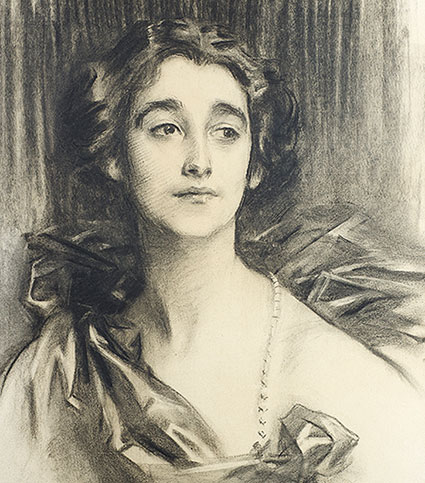John Singer Sargent’s Charcoal Portraits, Records of Artistic and Cultural Friendships, as Well as Networks of Patronage
John Singer Sargent (1856–1925) was one of the greatest portrait artists of his time. While he is best known for his powerful paintings, he largely ceased painting portraits in 1907 and turned instead to charcoal drawings to satisfy portrait commissions. These drawn portraits represent a substantial, yet often overlooked, part of his practice, and demonstrate the same sense of immediacy, psychological insight, and mastery of chiaroscuro that animate Sargent’s sitters on canvas. The Morgan Library & Museum is proud to present the first major exhibition to explore these expressive portraits in charcoal, John Singer Sargent: Portraits in Charcoal, on view now through January 12, 2020.

Recognizing the sheer scale of Sargent’s achievement as a portrait draftsman, this exhibition comprises over fifty drawings, including important international loans, from both public and private collections. The drawings showcase Sargent’s sitters, many of them famous for their roles in politics, society, and the arts. Sargent’s charcoal portraits are remarkable not only for their quantity — they number over 750 in total — but also for their vivid portrayal of the men and women who sat for him. The portraits become telling records of artistic and cultural friendships, as well as the networks of patronage that underpinned Sargent’s practice as a portrait draftsman in Edwardian Britain and Progressive Era America. These writers, actors, politicians, musicians, artists, patrons, and friends shaped not only Sargent’s life, but also the social and cultural fabric of the United States and Great Britain in the early twentieth century.
Above: John Singer Sargent, Sybil Sassoon, later Marchioness of Cholmondeley, 1912, charcoal, Private Collection
Important portraits in the exhibition include a drawing of Sybil Sassoon, a leading light of London society and a close friend of the artist. Sargent had known Sassoon since she was a girl, and his sensitive drawing portrays her on the threshold of adulthood. Another of Sargent’s sitters and closest friends included in the exhibition is the author Henry James. James had championed the young Sargent’s work, and the two Americans moved in the same transatlantic intellectual and cultural circles. Sargent also sought out sitters who interested him and offered to make their portraits, as with his drawing of Ethel Barrymore. Sargent’s striking charcoal captures the soulful eyes and commanding stage presence for which the American actress was known.

By the time Sargent switched his portraiture practice almost entirely to charcoal, he had developed a consistent format for his portrait drawings. Before he set to work, Sargent seemed to have a clear image in his mind of what he wanted to achieve. He focused on the head and shoulders of each sitter, depicting them a little less than life-size. After establishing key proportions and masses, he would develop the drawing in stages, elaborating details at the end. Often set against a dramatic dark background, these subjects have a powerful presence.
Many sitters recounted the speed and confidence with which Sargent worked; he finished most of these charcoals in less than three hours. The artist would often invite friends to drawing sessions to keep the sitters entertained and also to help enliven their features. The finished charcoal portraits are valuable testaments to Sargent’s prodigious skill as an artist and draftsman.
John Singer Sargent (1856 - 1925), Henry James (1843-1916) 1912, Charcoal. Royal Collection Trust / © Her Majesty Queen Elizabeth II 2019
Sargent had little interest in promoting his career as a portrait draftsman, and these charcoal drawings were rarely exhibited. While many of the portraits were commissions, a number were gifts from the artist to his sitters, tokens of Sargent’s admiration and affection for talented performers and valued friends. The portraits often remained in the private collections of the sitters and their descendants. This exhibition is the first in recent times to assemble such a wide selection of Sargent’s drawn portraits, and many of the works have never been publicly exhibited before.
Pages: 1 · 2
More Articles
- Jo Freeman Writes: Kennedy vs. Trump at the Libertarian National Convention
- Women's Health and Aging Studies Available Online; Inform Yourself and Others Concerned About Your Health
- Selective Exposure and Partisan Echo Chambers in Television News Consumption: Innovative Use of Data Yields Unprecedented Insights
- Jo Freeman's Review of Yippie Girl: Exploits in Protest and Defeating the FBI
- Jo Freeman Reviews Thank You For Your Servitude: Donald Trump's Washington and the Price of Submission
- "Henry Ford Innovation Nation", a Favorite Television Show
- Ferida Wolff's Backyard: Fireworks Galore!
- How They Did It: Tampa Bay Times Reporters Expose High Airborne Lead Levels at Florida Recycling Factory
- Veterans Health Care: Efforts to Hire Licensed Professional Mental Health Counselors and Marriage and Family Therapists
- Journalist's Resource: Religious Exemptions and Required Vaccines; Examining the Research






